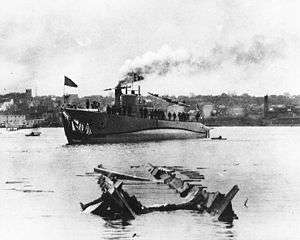USS Shark (SS-174)
 Shark, just after launch | |
| History | |
|---|---|
| Name: | USS Shark |
| Builder: | Electric Boat Company, Groton, Connecticut[1] |
| Laid down: | 24 October 1933[1] |
| Launched: | 21 May 1935[1] |
| Commissioned: | 25 January 1936[1] |
| Fate: | Probably sunk by Japanese destroyer Yamakaze east of Manado, 11 February 1942[2] |
| General characteristics | |
| Class and type: | Porpoise-class diesel-electric submarine[2] |
| Displacement: | |
| Length: | |
| Beam: | 25 ft .75 in (7.6391 m)[3] |
| Draft: | 13 ft 9 in (4.19 m)[5] |
| Propulsion: |
|
| Speed: | |
| Range: |
|
| Endurance: |
|
| Test depth: | 250 ft (76 m)[3] |
| Capacity: | 85,946–86,675 US gal (325,340–328,100 l)[11] |
| Complement: | 5 officers, 49 enlisted[3] |
| Armament: |
|
USS Shark (SS-174) was a Porpoise-class submarine, the fifth ship of the United States Navy to be named for the shark. Her keel was laid down by the Electric Boat Company in Groton, Connecticut, on 24 October 1933. She was launched on 21 May 1935 (sponsored by Miss Ruth Ellen Lonergan, 12-year-old daughter of United States Senator Augustine Lonergan of Connecticut), and commissioned on 25 January 1936, Lieutenant C.J. Carter in command.
Inter-war period
Asiatic Fleet
Following shakedown in the North Atlantic and the Caribbean Sea, Shark transited the Panama Canal and arrived at San Diego, California on 4 March 1937. She spent the next year and one-half in training exercises and Army-Navy war problems as a unit of Submarine Squadron 6 (SubRon 6). Following a regular overhaul at Mare Island Navy Yard, Vallejo, California, Shark got underway from San Diego on 16 December 1938 bound for Pearl Harbor and reassignment to SubRon 4.
Following two years of operations in the Hawaii area, Shark set sail from Pearl Harbor on 3 December 1940 to join the Asiatic Fleet based at Manila, where she engaged in fleet tactics and exercises until the Japanese attack on Pearl Harbor. Departing Manila on 9 December 1941, under command of Louis Shane, Jr. (USNA Class of 1926), she was at sea during the Japanese bombing raids on Manila the next day. For the next week, Shark patrolled Tayabas Bay until ordered back to Manila on 19 December to embark Admiral Thomas C. Hart, Commander-in-Chief, Asiatic Fleet, for transportation to Soerabaja, Java.
World War II
On 6 January 1942, Shark was almost hit with a torpedo from an Imperial Japanese Navy submarine. A few days later, she was ordered to Ambon Island, where an enemy invasion was expected. On 27 January, she was directed to join the submarines patrolling in Strait of Malacca, then to cover the passage east of Lifamatola and Bangka Strait. On 2 February, Shark reported to her base at Soerabaja that she had been depth-charged 10 mi (16 km) off Tifore Island and had failed to sink a Japanese ship during a torpedo attack. Five days later, she reported chasing an empty cargo ship headed northwest, for which the Asiatic Fleet Submarine Commander, Captain John E. Wilkes upbraided Shane.[13] No further messages were received from Shark. On 8 February, she was told to proceed to Makassar Strait and later was told to report information. Nothing was heard and, on 7 March, Shark was reported as presumed lost, the victim of unknown causes, the first American submarine lost to enemy anti-submarine warfare.[14] She was struck from the Naval Vessel Register on 24 June.
Post-war, Japanese records showed numerous attacks on unidentified submarines in Shark's area at plausible times. At 01:37 on 11 February, for example, the Japanese destroyer Yamakaze opened fire with her 5 in (130 mm) guns and sank a surfaced submarine. Voices were heard in the water, but no attempt was made to rescue possible survivors.
Awards
Shark received one battle star for World War II service.
References
- 1 2 3 4 Friedman, Norman (1995). U.S. Submarines Through 1945: An Illustrated Design History. Annapolis, Maryland: United States Naval Institute. pp. 285–304. ISBN 1-55750-263-3.
- 1 2 3 4 5 6 Bauer, K. Jack; Roberts, Stephen S. (1991). Register of Ships of the U.S. Navy, 1775–1990: Major Combatants. Westport, Connecticut: Greenwood Press. pp. 268–269. ISBN 0-313-26202-0.
- 1 2 3 4 5 6 7 8 9 10 U.S. Submarines Through 1945 pp. 305–311
- ↑ Lenton, H. T. American Submarines (New York: Doubleday, 1973), p.45.
- 1 2 3 Lenton, p.45.
- ↑ Alden, John D., Commander, USN (retired). The Fleet Submarine in the U.S. Navy (Annapolis, MD: Naval Institute Press, 1979), p.210.
- 1 2 3 Alden, p.210.
- ↑ U.S. Submarines Through 1945 pp.261–263
- ↑ Alden, p.211.
- ↑ total 2,085 hp (1,555 kW)
- ↑ Alden, p.58; Lenton, p.45, puts it at 347 tons.
- ↑ Lenton, pp.39 & 45.
- ↑ Blair, Clay, Jr. Silent Victory (New York: Bantam, 1976; reprints Lippincott 1975 edition), p.165.
- ↑ Blair, p.165.
- This article incorporates text from the public domain Dictionary of American Naval Fighting Ships. The entry can be found here.
External links
Coordinates: 1°45′N 127°15′E / 1.750°N 127.250°E